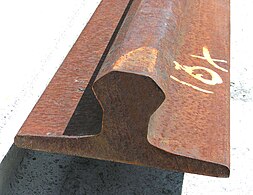| Revision as of 17:04, 23 May 2023 editPeter Horn (talk | contribs)Autopatrolled, Extended confirmed users, IP block exemptions, Pending changes reviewers104,703 edits →Description: + File:Scambio Translohr Deposito Favaro 071120.jpg|Translohe switch & File:Guide rail used in the Translohr guidance system for rubber-tyred trams.jpg|Translohr system guide rail X section← Previous edit | Revision as of 18:13, 23 May 2023 edit undoVoidxor (talk | contribs)Extended confirmed users, Pending changes reviewers, Rollbackers37,896 editsm script-assisted date audit and style fixes per MOS:NUMNext edit → | ||
| Line 1: | Line 1: | ||
| {{short description|Rubber-tired tramway (or guided bus) system}} | {{short description|Rubber-tired tramway (or guided bus) system}} | ||
| {{Use dmy dates|date= |
{{Use dmy dates|date=May 2023}} | ||
| {{More citations needed|date=August 2015}} | {{More citations needed|date=August 2015}} | ||
| ] | ] | ||
| '''Translohr''' is a ] (or ]) system, originally developed by ] of France and now run by a consortium of ] and ] (FSI) as ''],''<ref></ref> which took over from Lohr in 2012. It is used in ] and ], France; ], Colombia; ] and ], China; and ] and ] in Italy.<ref>{{Cite web|url=http://www.ferrovie.it/portale/leggi.php?id=1378|title=Ferrovie.it - Il Translohr arriva a Venezia}}</ref> In June 2012, ] and the ] acquired Translohr for €35 million.<ref>{{Cite news|url=http://www.lemonde.fr/economie/article/2012/06/11/alstom-et-le-fsi-rachetent-translohr-pour-35-millions-d-euros_1716640_3234.html|title=Alstom et le FSI rachètent Translohr pour 35 millions d'euros|date=2012 |
'''Translohr''' is a ] (or ]) system, originally developed by ] of France and now run by a consortium of ] and ] (FSI) as ''],''<ref></ref> which took over from Lohr in 2012. It is used in ] and ], France; ], Colombia; ] and ], China; and ] and ] in Italy.<ref>{{Cite web|url=http://www.ferrovie.it/portale/leggi.php?id=1378|title=Ferrovie.it - Il Translohr arriva a Venezia}}</ref> In June 2012, ] and the ] acquired Translohr for €35 million.<ref>{{Cite news|url=http://www.lemonde.fr/economie/article/2012/06/11/alstom-et-le-fsi-rachetent-translohr-pour-35-millions-d-euros_1716640_3234.html|title=Alstom et le FSI rachètent Translohr pour 35 millions d'euros|date=11 June 2012|work=Le Monde.fr|access-date=21 November 2017|language=fr|issn=1950-6244}}</ref> | ||
| ==Description== | ==Description== | ||
Revision as of 18:13, 23 May 2023
Rubber-tired tramway (or guided bus) system
| This article needs additional citations for verification. Please help improve this article by adding citations to reliable sources. Unsourced material may be challenged and removed. Find sources: "Translohr" – news · newspapers · books · scholar · JSTOR (August 2015) (Learn how and when to remove this message) |

Translohr is a rubber-tired tramway (or guided bus) system, originally developed by Lohr Industrie of France and now run by a consortium of Alstom Transport and Fonds stratégique d'investissement (FSI) as newTL, which took over from Lohr in 2012. It is used in Paris and Clermont-Ferrand, France; Medellín, Colombia; Tianjin and Shanghai, China; and Venice-Mestre and Padua in Italy. In June 2012, Alstom Group and the Strategic Investment Fund acquired Translohr for €35 million.
Description
The Translohr system is intended to provide a tram or light rail-like experience compared to regular buses or trolleybuses. Unlike other guided bus systems (including the similar but incompatible Guided Light Transit system developed by Bombardier Transportation), Translohr cars are permanently fixed to guide rails, and cannot divert from them, similar to traditional steel-wheeled rail vehicles.
Since the guide rail automatically guides the vehicle along its route, accelerating and braking are the only functions the driver controls. Like a conventional tram, power is provided by overhead wires and collected with a pantograph. The vehicle can also be run on internal batteries (arranged in packs) on sections of the route without overhead wires.
There are two main designs for the vehicles: the bi-directional STE series, and the unidirectional SP Prime series. They consist of three to six articulated sections like a conventional tram, with a length from 25 to 46 metres (82 ft 1⁄4 in to 150 ft 11 in) long and 2.2 metres (7 ft 2+5⁄8 in) wide. Their net weight is 23–44 tonnes (22.6–43.3 long tons; 25.4–48.5 short tons), depending upon the number of car sections.
Translohr LRVs cannot run without a guide rail therefore they are not classified as buses. Hence, vehicles that are used on the Clermont-Ferrand network do not have license plates.
-
 Translohr guide rail
Translohr guide rail
-
 Translohr system guide rail X section
Translohr system guide rail X section
-
 Translohr rail crossing
Translohr rail crossing
-
 Translohe switch
Translohe switch
-
 Translohr in Medellín
Translohr in Medellín
Criticism
The Translohr system is more expensive than conventional trams or light rail systems, with higher building and operating costs. The 14 km (8.7 mi) Châtillon–Viroflay Line in Paris cost €27.4m per km, including infrastructure, improvements of the right-of-way, and the purchase of 28 STE6 vehicles. In addition, due to the tyres constantly running over the same area of road, there is significant erosion of the roadway; this has already happened with Bombardier Guided Light Transit transit system, resulting in extensive repairs at significant cost to the operator. This adds to already high running costs. Providing rollways embeded in the pavement might have been useful. Ride quality is also said to be poor and is not much of an improvement over a standard bus due to the four-wheeled design, whereas trams have trucks (bogies) with shock absorbers and/or springs.
The Tianjin system suffered a derailment on 20 August 2007, three months after its inauguration. There were five derailments on Padua's new installation in 2007 before its inauguration, and one on 22 April 2010 due to a misaligned switch.
Where snowfall is an issue, this system may not be practical: since the guide rail forms the return leg of the electrical circuit, accumulation of ice and snow on the rail could cause intermittent power interruptions to the vehicle. Also, as the vehicle does not place a significant portion of its weight on the guide wheels (most of it being supported by the rubber tyres), snow packed into the flangeways or atop the rail by road traffic might possibly lift the guide wheels off the rail, leading the vehicle to go off course. However, since the guide wheels each grip the guide rail at a 45 degree angle and thus are at 90 degree angle to each other, the inconvenience may be minimal.
Critics of the system also point out that, unlike a conventional tramway, Translohr is a proprietary system, meaning that once it is installed, a city would suffer vendor lock-in, or difficulties in buying vehicles from any manufacturer other than Lohr Industrie.
When the patents shall have expired, this will no longer be an issue.
See also
- Bombardier Guided Light Transit
- CRRC Autonomous Rail Rapid Transit
- List of rubber-tyred tram systems
- Right-of-way (transportation)
- Roll way
- TEDA Modern Guided Rail Tram
- Tram
- Tramways in Île-de-France
- Tyre
References
- newTL
- "Ferrovie.it - Il Translohr arriva a Venezia".
- "Alstom et le FSI rachètent Translohr pour 35 millions d'euros". Le Monde.fr (in French). 11 June 2012. ISSN 1950-6244. Retrieved 21 November 2017.
- "La ligne de tramway T6 entre Châtillon et Viroflay achevée". 11 May 2016.
- "Nantes Transit Riders Prefer Qualities of BRT over Trams (Versus, suburbs, issues) - Urban Planning -Urban, city, town planning, land use, zoning, transportation and transit, environmental issues, urban design, community development, subdivisions, revitalization - City-Data Forum".
- "国内首条现代导轨电车出轨 (lit. the first modern guided tram in China derails". QQ.com.
- ^ ""Guided-bus" ("BRT") plagued by derailments". Light Rail Now! Newslog. Light Rail Now! Project. 13 May 2007.
- TGPadova.it - tram derails, chaos on board, no casualties (in Italian)
- tram derailed, travel by bus - il mattino di Padova dal 2003.it (in Italian)
- "There's another one behind!". Tramways & Urban Transit. Light Rail Transit Association. May 2001. Archived from the original on 27 November 2006.
External links
- Hondius, Harry: Translohr – Straßenbahn auf Gummireifen: Stand der Entwicklung. Stadtverkehr 5/2015, p. 8–12.
- Translohr official site
- Translohr 2.0